Application of an Online-Coupled Regional Climate Model, WRF-CAM5, over East Asia for Examination of Ice Nucleation Schemes: Part I. Comprehensive Model Evaluation and Trend Analysis for 2006 and 2011
Abstract
:1. Introduction
2. Simulation Episodes, Model Configurations, and Evaluation Protocols
2.1. Modeling Episode and Setup
| Attribute | Model Configuration |
|---|---|
| Model | WRF-CAM5 |
| Simulation period | 18 December 2005 to 31 December 2006 (spinup from 18–31 December 2005) |
| Domain | East Asia |
| Horizontal resolution | 36 km (164 × 97) |
| Vertical resolution | 23 layers from 1000 mb to 100 mb, with 8 layers in PBL |
| Shortwave radiation | The Rapid Radiative Transfer Method for GCMs (RRTMG) ([15,16]) |
| Longwave radiation | RRTMG ([15,16]) |
| Land surface | Community NCEP, Oregon State University, Air Force, and Hydrologic Research Lab-NWS Land Surface Model (NOAH) ([17]) |
| Surface layer | Monin-Obukhov ([18,19]) |
| PBL | UW boundary layer scheme from CAM5 ([20]) |
| Cumulus | Zhang-MaCfarlane ([21]) with modifications from Song and Zhang ([22]) |
| Microphysics | Morrison two-moment scheme ([23]) |
| Aerosol activation | Abdul-Razzak and Ghan ([25]) |
| Ice nucleation | Liu et al. ([27]) |
| Heterogeneous ice nucleation | Meyers ([10]) in the base simulation Niemand ([11]) in the sensitivity simulation |
| Gas-phase chemistry | Carbon-Bond mechanism version Z (CBMZ) ([30]) |
| Photolysis | Fast Tropospheric Ultraviolet-Visible (FTUV) ([24]) |
| Aerosol module | A modal aerosol model with three lognormal modes (MAM3) ([9]) |
| Aqueous-phase chemistry | Barth et al. ([31]) |
| Meteorological IC and BC | NCEP-FNL reanalysis data; re-initialization every 5 days |
| Chemical IC | Community Multiscale Air Quality (CMAQ) modeling system ([32]) |
| Chemical BC | The Goddard Earth Observing System Atmospheric Chemistry Transport Model (GEOS-Chem) |
| Anthropogenic emissions | Multi-resolution Emission Inventory for China (MEIC) and the Intercontinental Chemical Transport Experiment-Phase B (INTEX-B) for the rest of the domain ([33]) |
| Biogenic emissions | Model of Emissions of Gases and Aerosols from Nature (MEGAN) version 2 ([34]) |
| Dust emissions | Zender et al. ([35]) implemented by Wang et al. ([36]) |
| Sea-salt emissions | Gong et al. ([37]) |
2.2. Observational Datasets and Evaluation Metrics
| Database* | Type | Sites | Variables/Species | Data Frequency |
|---|---|---|---|---|
| NCDC | Meteorology | Domain-wide | Precip (mm∙day−1) | Daily |
| T2 (°C) | Every 6 | |||
| RH (%) | ||||
| Q2 (kg∙kg−1) | ||||
| WS10 (m∙s−1) | ||||
| CERES | Meteorology | Domain-wide | SWD (W∙m−2) | Monthly |
| GLW (W∙m−2) | ||||
| SWCF (W∙m−2) | ||||
| LWCF (W∙m−2) | ||||
| GCPC | Meteorology | Domain-wide | Precip (mm∙day−1) | Monthly |
| OMI | Column | Domain-wide | TOR (Dobson Unit)(DU) | Monthly |
| SCIAMACHY | Column | Domain-wide | SO2(DU) | Monthly |
| NO2 (1015 molecules∙cm−2) HCHO(1015 molecules∙cm−2) | ||||
| MOPITT | Column | Domain-wide | CO (1017 molecules∙cm−2) | Monthly |
| MODIS/TERRA | Column | Domain-wide | CDNC (cm−3) | Monthly |
| AOD | ||||
| COT | ||||
| LWP (g∙m−2) | ||||
| IWP (g∙m−2) | ||||
| PWV (cm) | ||||
| CCN (# cm−2) (ocean) | ||||
| MEP | Chemistry | Mainland China | SO2, NO2, PM10 | Daily |
| NIES | Chemistry | Japan | CO, NO, NO2, O3, SO2, and PM10 | Monthly |
| AQMN | Chemistry | Taiwan | CO, NO, NO2, O3, SO2, PM2.5 and PM10 | Hourly |
| EPD | Chemistry | Hong Kong | CO, NO2, O3, SO2, PM2.5 and PM10 | Hourly |
| AirKorea | Chemistry | South Korea | CO, NO2, O3, SO2, and PM10 | Monthly |
| Beijing | Chemistry | THU (Beijing) | PM2.5, SO42−, NO3−, Na+, Cl−, and NH4+ | Weekly |
| Miyun (Beijing) | ||||
| EANET | Chemistry | Mainland China, Japan, and South Korea | NO, NO2, O3, SO2, PM2.5 , PM10, and SO42− | Monthly |
3. Evaluation of Baseline Simulations
3.1. Meteorological Predictions
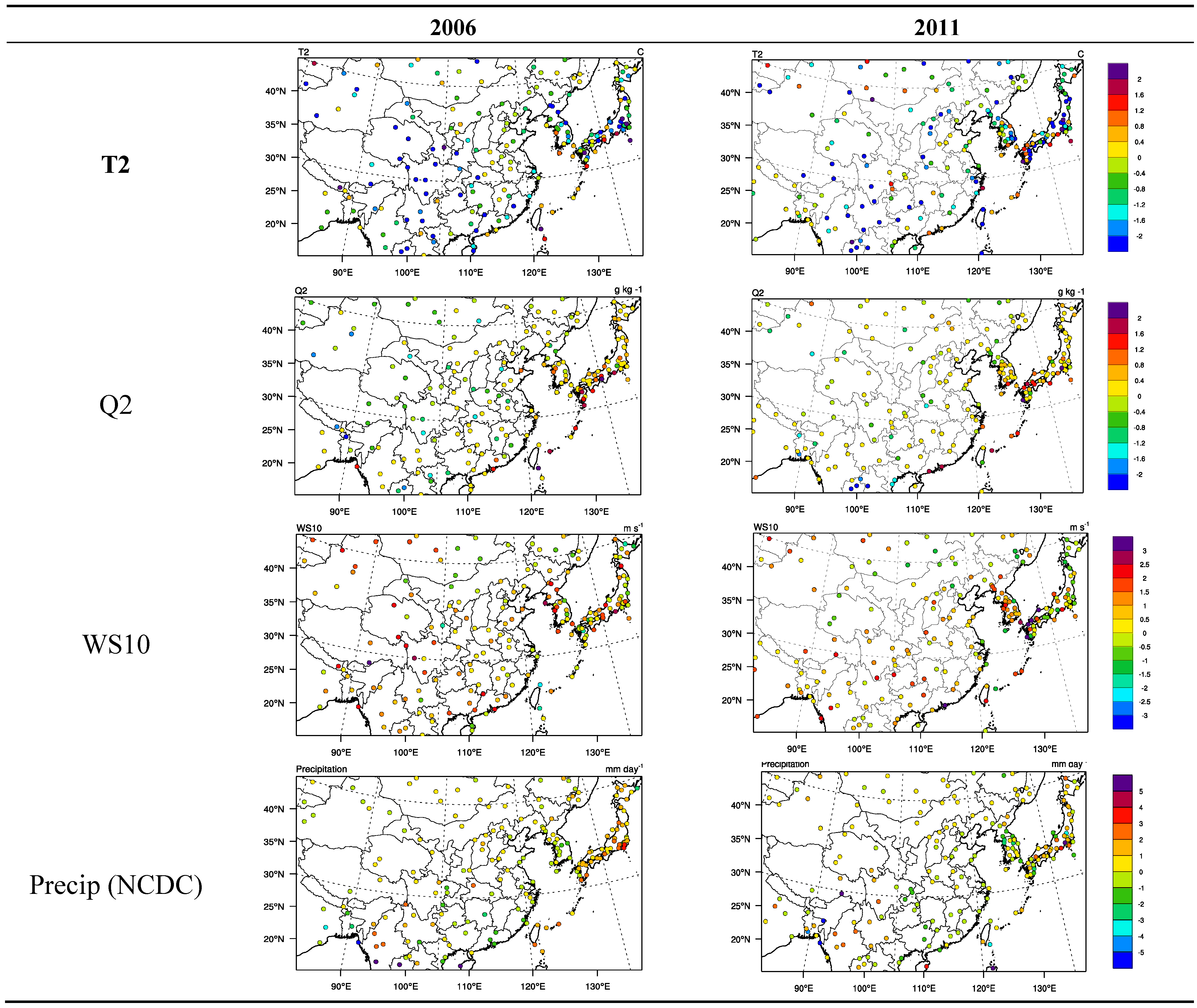
| Variable | Data Source | Number | Mean Obs. | Sim. | Mean Sim. | R | NMB (%) | NME (%) | MB | MAGE | RMSE | FB | FGE | IOA |
|---|---|---|---|---|---|---|---|---|---|---|---|---|---|---|
| P (mb) | NCDC | 6946 | 939.7 | M92 | 925.8 | 0.96 | −1.5 | 2.4 | −13.9 | 22.2 | 35.9 | −0.02 | 0.03 | 1.0 |
| T2 (°C) | NCDC | 10524 | 13.8 | M92 | 12.9 | 0.98 | −7 | 14 | −0.9 | 1.9 | 2.7 | 0.92 | −0.93 | 1.0 |
| Q2 (g∙kg−1) | NCDC | 6945 | 8.0 | M92 | 8.0 | 0.98 | 0.4 | 11 | 0.03 | 0.8 | 1.2 | 0.00 | 0.13 | 1.0 |
| WS10 (m∙s−1) | NCDC | 8010 | 3.1 | M92 | 3.4 | 0.54 | 11 | 32 | 0.3 | 1.0 | 1.3 | 0.10 | 0.29 | 0.7 |
| Precip (mm∙day−1) | NCDC | 10131 | 2.7 | M92 | 3.0 | 0.68 | 14 | 62 | 0.4 | 1.7 | 3.1 | - | - | 0.8 |
| GPCP | 15908 | 2.9 | M92 | 3.1 | 0.76 | 9 | 37 | 0.3 | 1.0 | 1.5 | −0.02 | 0.40 | 0.9 | |
| CCN (cm−2) | MODIS | 4917 | 0.8 | M92 | 0.5 | 0.78 | −33.8 | 40.9 | −0.3 | 0.3 | 0.7 | −0.2 | 0.3 | |
| CDNC (cm−3) | 9111 | 143.0 | M92 | 101.0 | 0.63 | −29.3 | 36.2 | −41.9 | 51.7 | 65.2 | −0.4 | 0.5 | ||
| CF | 13398 | 0.6 | M92 | 0.6 | 0.81 | −12.0 | 17.2 | −0.1 | 0.1 | 0.1 | −0.2 | 0.2 | ||
| PWV (cm) | 13398 | 2.2 | M92 | 2.2 | 0.99 | −0.9 | 6.3 | 0.0 | 0.1 | 0.2 | 0.05 | 0.1 | ||
| LWP (g∙m−2) | 13398 | 110.3 | M92 | 48.0 | 0.87 | −56.5 | 56.6 | −62.3 | 62.4 | 65.6 | −1.0 | 1.0 | ||
| IWP (g∙m−2) | 13398 | 245.1 | M92 | 9.5 | 0.01 | −96.1 | 96.1 | −235.6 | 235.6 | 243.9 | −1.8 | 1.8 | ||
| AOD | 13070 | 0.3 | M92 | 0.2 | 0.70 | −35.7 | 43.6 | −0.1 | 0.1 | 0.2 | −0.5 | 0.6 | ||
| COT | 13398 | 16.3 | M92 | 8.2 | 0.84 | −50.0 | 50.3 | −8.2 | 8.2 | 8.9 | −0.8 | 0.8 | ||
| GLW (W∙m−2) | CERES | 13398 | 324.6 | M92 | 317.4 | 0.99 | −2.2 | 2.6 | −7.2 | 8.4 | 12.0 | −0.03 | 0.03 | |
| SWD (W∙m−2) | 13398 | 183.4 | M92 | 204.9 | 0.91 | 11.7 | 11.8 | 21.5 | 21.6 | 25.0 | 0.1 | 0.1 | ||
| SWCF (W∙m−2) | 13398 | −51.7 | M92 | −42.0 | 0.90 | −18.7 | 21.2 | −9.7 | 10.9 | 13.3 | −0.3 | 0.3 | ||
| LWCF (W∙m−2) | 13398 | 29.1 | M92 | 18.5 | 0.68 | −36.4 | 36.5 | −10.6 | 10.6 | 11.6 | −0.5 | 0.5 |
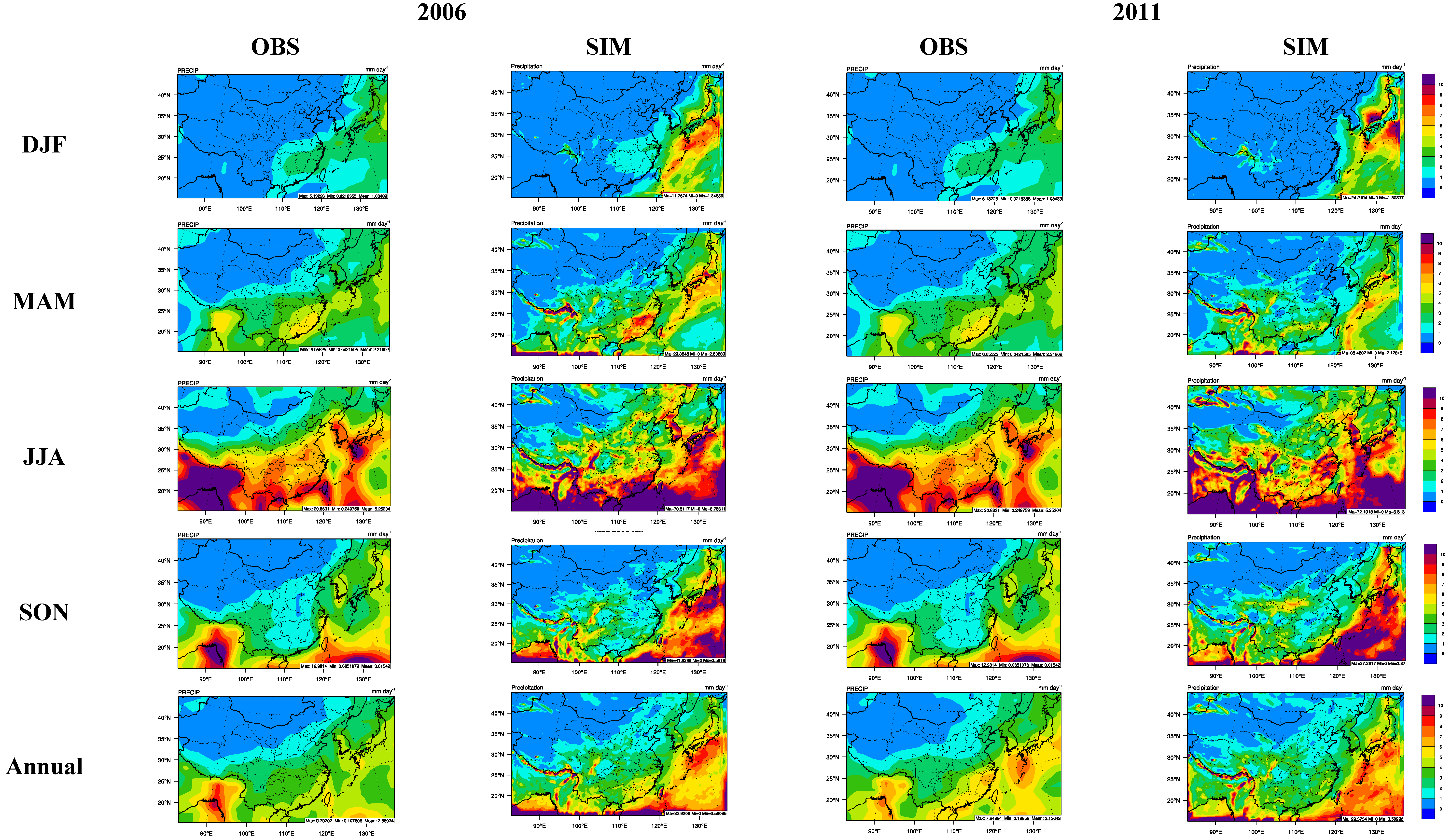
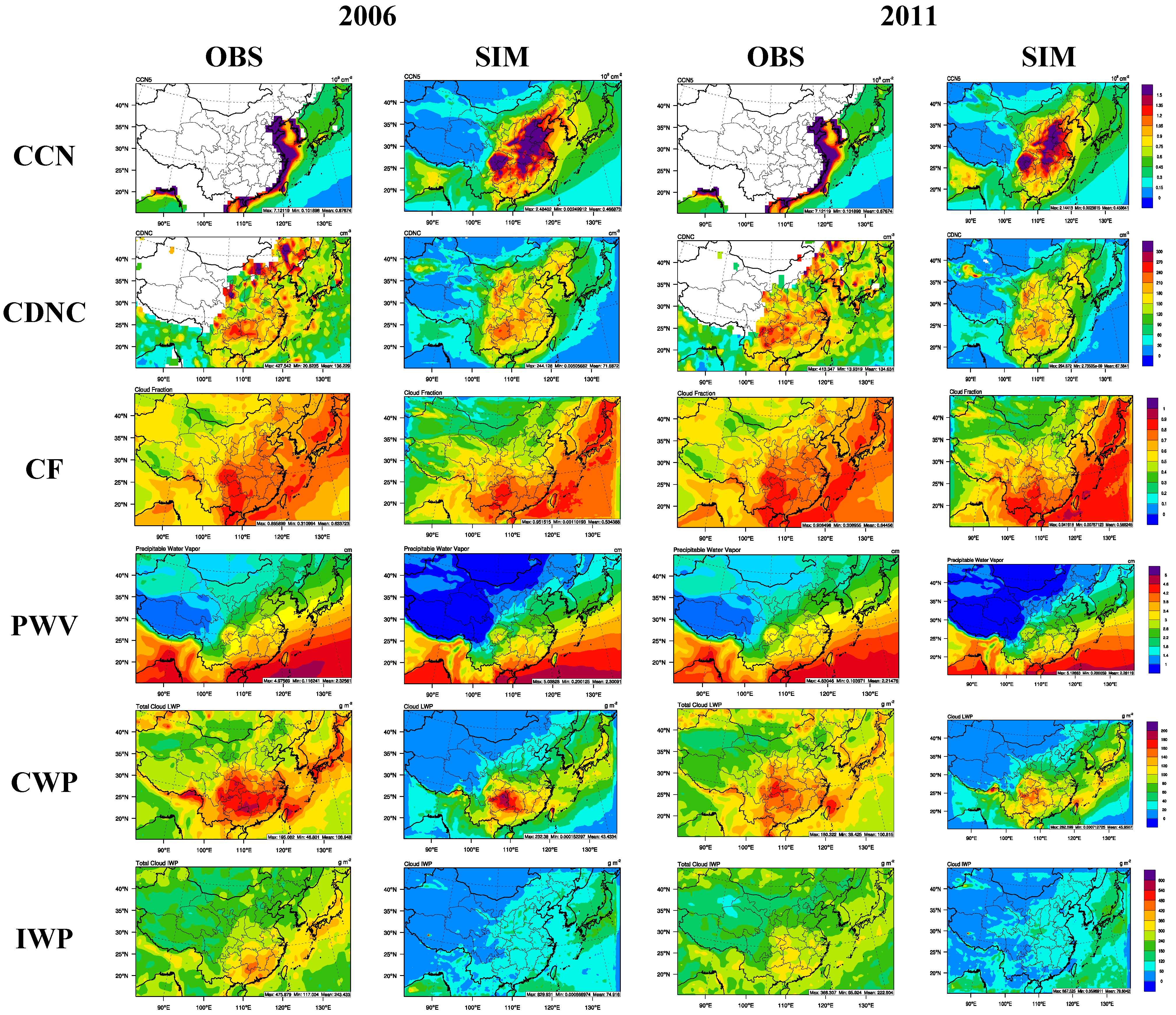
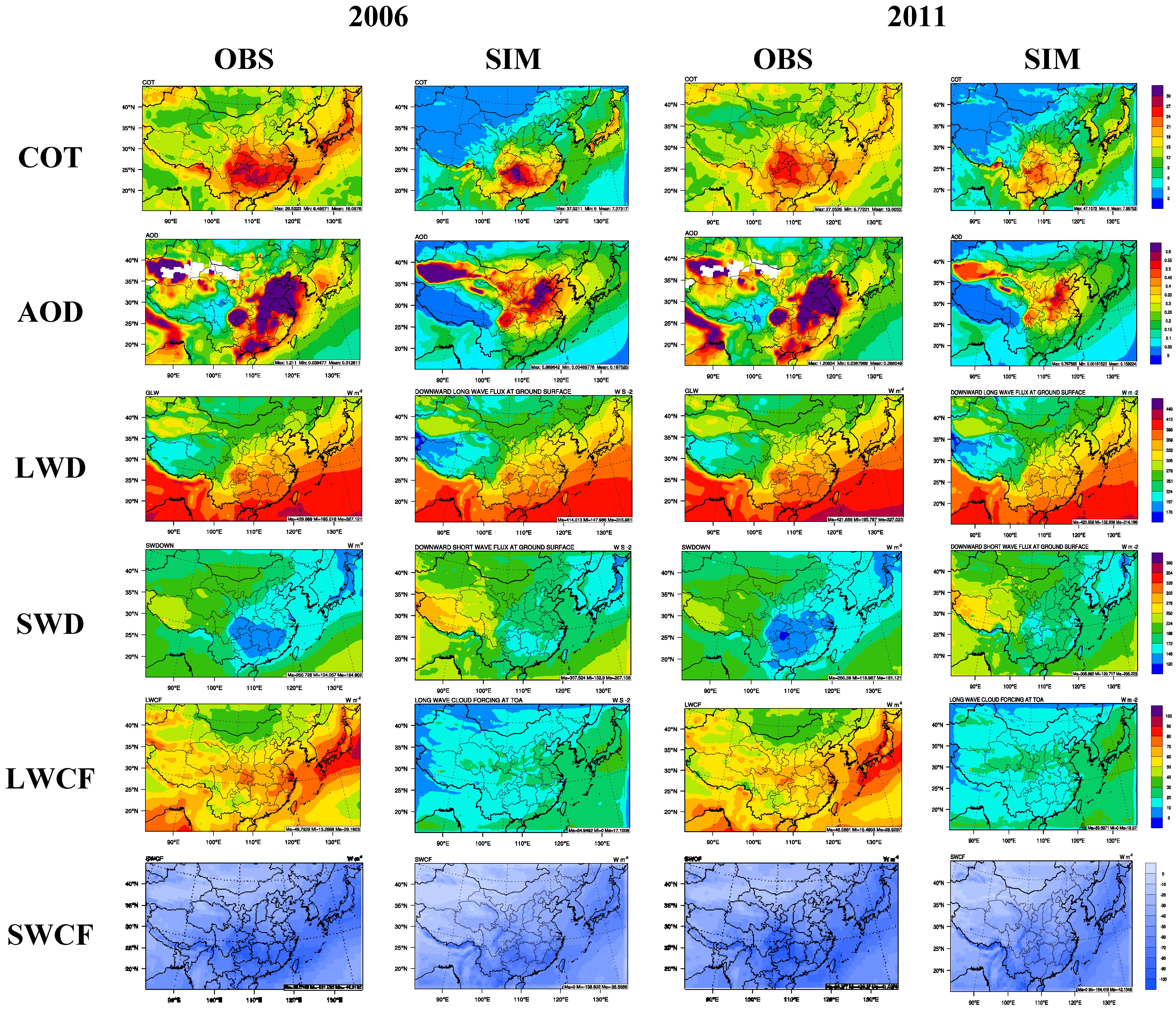
3.2. Chemical Predictions
| Variable | Data Source | Number | Mean Obs. | Mean Sim. | R | NMB (%) | NME (%) | MB | MAGE | RMSE | FB | FGE |
|---|---|---|---|---|---|---|---|---|---|---|---|---|
| CO (µg·m−3) | HK | 8760 | 855.7 | 703.6 | 0.41 | −17.8 | 33.8 | −152.1 | 289.0 | 380.7 | −0.23 | 0.37 |
| CO (ppm) | TW | 324 | 0.5 | 0.2 | 0.39 | −48.0 | 50.1 | −0.2 | 0.2 | 0.3 | −0.57 | 0.62 |
| JP | 1390 | 0.5 | 0.2 | 0.03 | −63.7 | 64.1 | −0.3 | 0.3 | 0.4 | −0.87 | 0.88 | |
| SK | 731 | 0.6 | 0.2 | 0.28 | −62.0 | 62.3 | −0.4 | 0.4 | 0.4 | −0.82 | 0.83 | |
| Col. CO (1018 molec.·cm−2) | MOPPIT | 13398 | 2.0 | 2.0 | 0.94 | 0.3 | 7.5 | 0.01 | 0.2 | 0.2 | 0.00 | 0.08 |
| NO (µg·m−3) | HK | 8758 | 103.5 | 13.8 | 0.30 | −86.6 | 86.7 | −89.7 | 89.8 | 109.2 | −1.57 | 1.57 |
| NO (ppb) | TW | 324 | 5.8 | 0.8 | 0.66 | −86.7 | 86.7 | −5.0 | 5.0 | 6.6 | −1.47 | 1.47 |
| JP | 2670 | 7.8 | 0.5 | −0.02 | −93.7 | 94.3 | −7.3 | 7.4 | 10.3 | −1.55 | 1.63 | |
| NO2 (µg·m−3) | CH | 40 | 125.8 | 16.0 | 0.04 | −87.3 | 87.3 | −109.8 | 109.8 | 118.3 | −1.59 | 1.59 |
| HK | 8760 | 62.1 | 60.6 | 0.46 | −2.4 | 41.3 | −1.5 | 25.7 | 33.2 | −0.09 | 0.43 | |
| NO2 (ppb) | TW | 324 | 15.2 | 8.1 | 0.20 | −47.0 | 52.7 | −7.2 | 8.0 | 10.2 | −0.57 | 0.69 |
| JP | 2670 | 12.2 | 5.0 | −0.07 | −59.0 | 70.5 | −7.2 | 8.6 | 10.6 | −0.8 | 1.00 | |
| SK | 732 | 17.4 | 9.8 | 0.16 | −43.3 | 60.7 | −7.5 | 10.6 | 13.0 | −0.49 | 0.80 | |
| Col. NO2 (1015 molec.·cm−2) | SCIAMACHY | 13398 | 2.3 | 2.5 | 0.91 | 7.6 | 34.2 | 0.2 | 0.8 | 1.8 | 0.07 | 0.36 |
| SO2 (µg·m−3) | CH | 2600 | 101.5 | 67.1 | −0.12 | −33.9 | 66.9 | −34.4 | 67.9 | 88.9 | −0.56 | 0.82 |
| HK | 8760 | 21.8 | 79.9 | 0.19 | 265.8 | 273.0 | 58.0 | 59.6 | 78.6 | 1.03 | 1.07 | |
| SO2 (ppb) | TW | 324 | 4.3 | 1.5 | 0.05 | −66.4 | 74.1 | −2.9 | 3.2 | 3.8 | −1.05 | 1.10 |
| JP | 2612 | 2.7 | 1.2 | −0.18 | −56.9 | 72.8 | −1.6 | 2.0 | 2.6 | −0.66 | 0.99 | |
| SK | 732 | 5.0 | 3.6 | 0.32 | −28.3 | 52.5 | −1.4 | 2.6 | 3.5 | −0.31 | 0.63 | |
| Col. SO2 (DU) | SCIAMACHY | 13398 | 0.2 | 0.3 | 0.87 | 62.9 | 103.5 | 0.1 | 0.2 | 0.4 | −0.15 | 0.72 |
| Col. HCHO (1015 molec.·cm−2) | SCIAMACHY | 13398 | 5.3 | 6.1 | 0.83 | 15.0 | 26.1 | 0.0 | 0.8 | 1.9 | 0.06 | 0.25 |
| O3 (µg·m−3) | HK | 8760 | 35.8 | 43.8 | 0.52 | 22.4 | 87.5 | 8.0 | 31.3 | 46.0 | −0.35 | 0.95 |
| O3 (ppb) | TW | 324 | 31.3 | 37.2 | 0.33 | 18.9 | 28.6 | 5.9 | 8.9 | 10.9 | 0.18 | 0.26 |
| JP | 2355 | 31.6 | 35.2 | 0.48 | 11.1 | 23.3 | 3.5 | 7.4 | 9.2 | 0.13 | 0.23 | |
| SK | 732 | 25.5 | 36.0 | 0.44 | 40.9 | 52.9 | 10.4 | 13.5 | 16.3 | 0.34 | 0.45 | |
| TOR (DU) | OMI | 13398 | 30.7 | 33.6 | 0.95 | 9.5 | 9.7 | 2.9 | 3.0 | 3.4 | 0.09 | 0.09 |
| PM2.5 (µg·m−3) | HK | 8757 | 40.8 | 103.4 | 0.31 | 153.6 | 167.2 | 62.7 | 68.2 | 111.8 | 0.64 | 0.77 |
| TW | 324 | 31.7 | 15.9 | 0.22 | −49.7 | 52.7 | −15.8 | 16.7 | 20.9 | −0.62 | 0.66 | |
| PM10 (µg·m−3) | CH | 1030 | 98.6 | 97.8 | 0.09 | −0.8 | 58.0 | −0.8 | 57.2 | 74.5 | −0.12 | 0.60 |
| HK | 8760 | 58.7 | 105.1 | 0.30 | 79.0 | 104.7 | 46.4 | 61.5 | 103.6 | 0.33 | 0.60 | |
| TW | 324 | 57.6 | 19.7 | 0.25 | −65.8 | 66.1 | −37.9 | 38.1 | 44.1 | −0.95 | 0.96 | |
| JP | 2719 | 23.4 | 13.3 | −0.01 | −42.9 | 52.9 | −10.0 | 12.4 | 15.1 | −0.56 | 0.67 | |
| SK | 789 | 47.9 | 30.2 | 0.27 | −37.0 | 46.0 | −17.7 | 22.0 | 26.5 | −0.50 | 0.58 |
| Variable | Region | Number | Mean Obs. | Mean Sim. | R | NMB (%) | NME (%) | MB | MAGE | RMSE | FB | FGE | |
|---|---|---|---|---|---|---|---|---|---|---|---|---|---|
| NO (ppb) | CH | 24 | 3.0 | 0.4 | 0.53 | −86.8 | 86.9 | −2.6 | 2.6 | 3.5 | −1.23 | 1.23 | |
| JP | 12 | 3.7 | 1.3 | −0.43 | −66.2 | 66.2 | −2.4 | 2.4 | 2.5 | −0.99 | 0.99 | ||
| NO2 (ppb) | CH | 24 | 17.6 | 4.3 | 0.61 | −75.4 | 75.4 | −13.3 | 13.3 | 14.7 | −1.37 | 1.37 | |
| JP | 12 | 3.7 | 1.3 | −0.43 | −66.2 | 66.2 | −2.4 | 2.4 | 2.5 | −0.99 | 0.99 | ||
| SO2 (ppb) | CH | 48 | 11.0 | 6.3 | 0.41 | −42.2 | 54.7 | −4.6 | 6.0 | 8.3 | −0.66 | 0.82 | |
| JP | 106 | 0.6 | 0.4 | 0.62 | −29.8 | 59.3 | −0.2 | 0.4 | 0.5 | −0.76 | 0.98 | ||
| SK | 36 | 2.5 | 0.1 | 0.75 | −96.9 | 96.9 | −2.4 | 2.4 | 2.6 | −1.88 | 1.88 | ||
| O3 (ppb) | JP | 118 | 41.7 | 34.9 | 0.26 | −16.2 | 32.4 | −6.8 | 13.5 | 16.1 | −0.14 | 0.38 | |
| SK | 36 | 37.1 | 30.0 | 0.17 | −19.1 | 28.2 | −7.1 | 10.5 | 13.1 | −0.20 | 0.31 | ||
| PM2.5 (µg m−3) | JP | 24 | 11.7 | 4.4 | 0.07 | −62.0 | 62.0 | −7.2 | 7.2 | 8.7 | −0.87 | 0.87 | |
| SO4 (µg m−3) | JP | 120 | 4.3 | 2.3 | −0.05 | −47.8 | 63.8 | −2.0 | 2.8 | 3.7 | −0.46 | 0.82 | |
| SK | 35 | 7.7 | 1.6 | −0.36 | −79.6 | 79.6 | −6.1 | 6.1 | 7.7 | −1.2 | 1.2 | ||
| PM10 (µg m−3) | CH | 48 | 71.0 | 41.3 | 0.53 | −41.8 | 56.0 | −29.7 | 39.7 | 50.3 | −0.68 | 0.71 | |
| JP | 117 | 21.7 | 13.1 | 0.25 | −39.9 | 51.9 | −8.7 | 11.3 | 14.1 | −0.52 | 0.68 | ||
| SK | 36 | 50.0 | 9.5 | 0.03 | −81.0 | 81.0 | −40.5 | 40.5 | 43.3 | −1.35 | 1.35 | ||
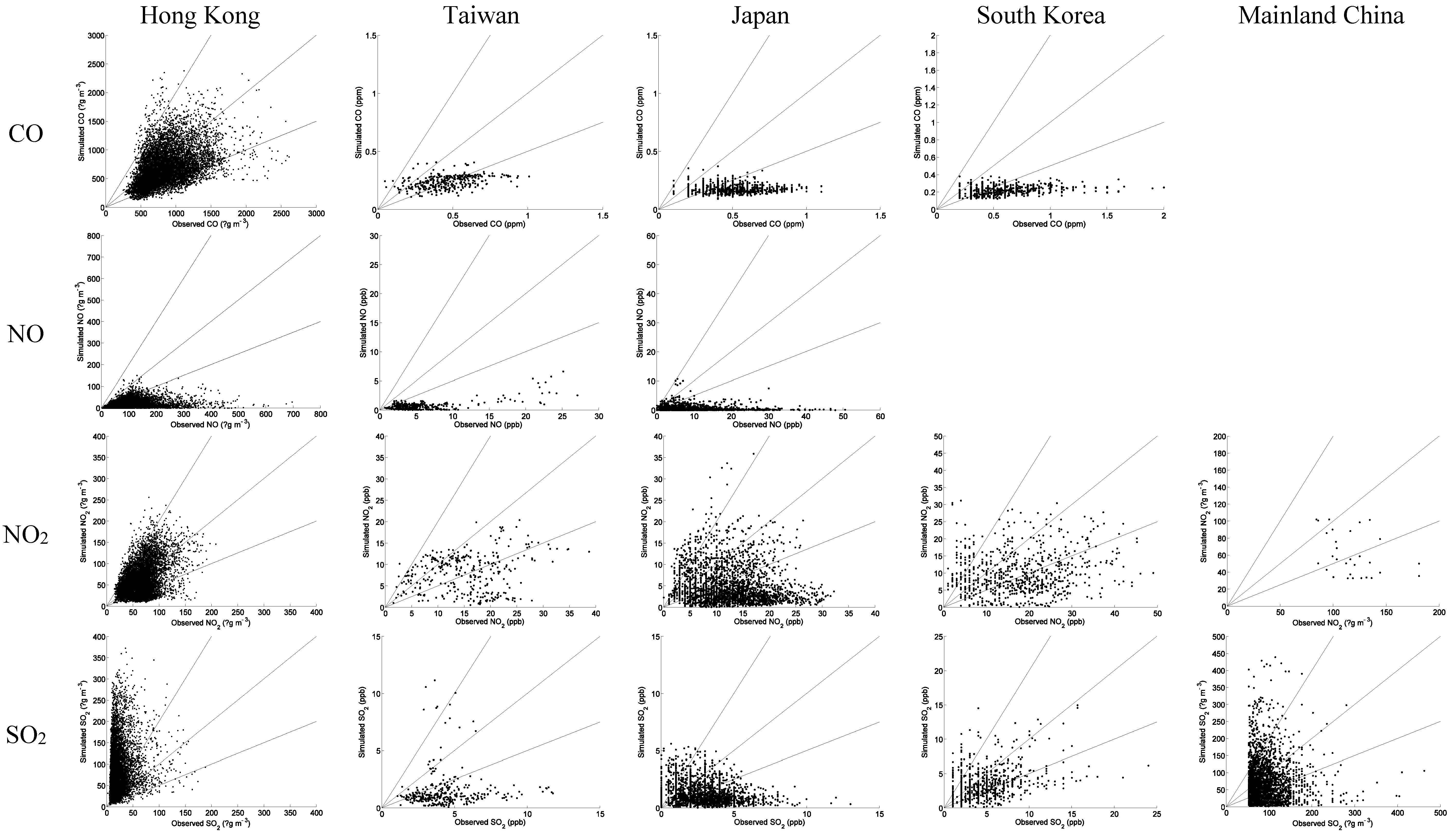
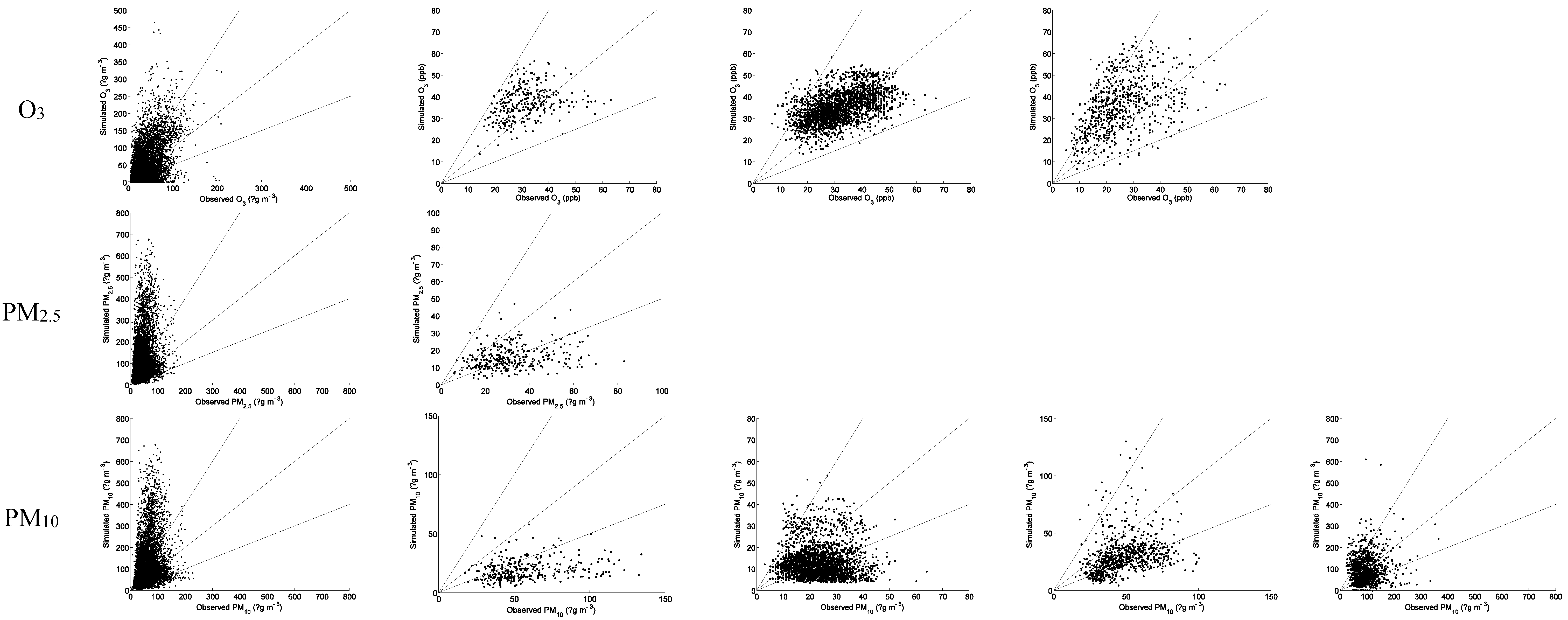
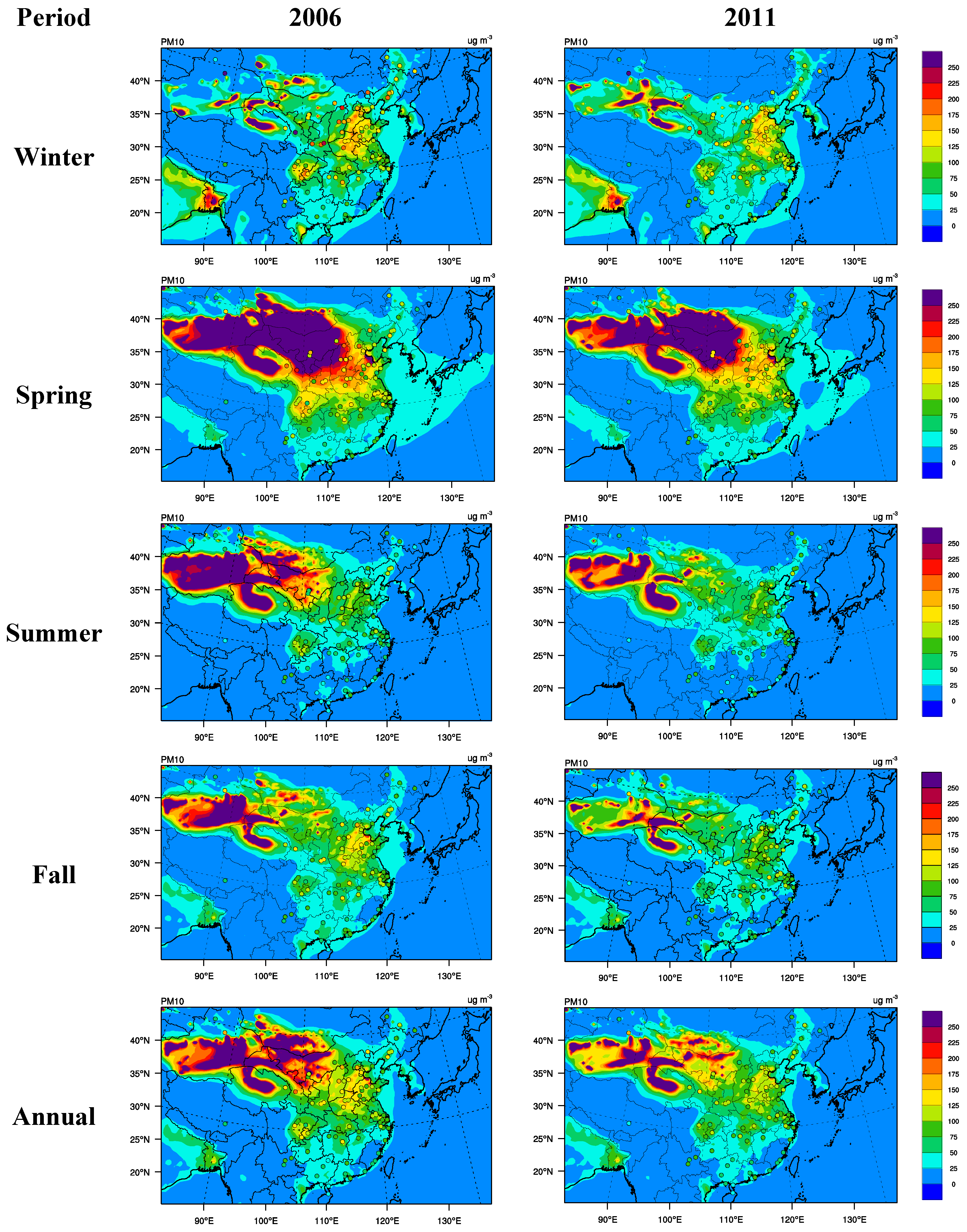
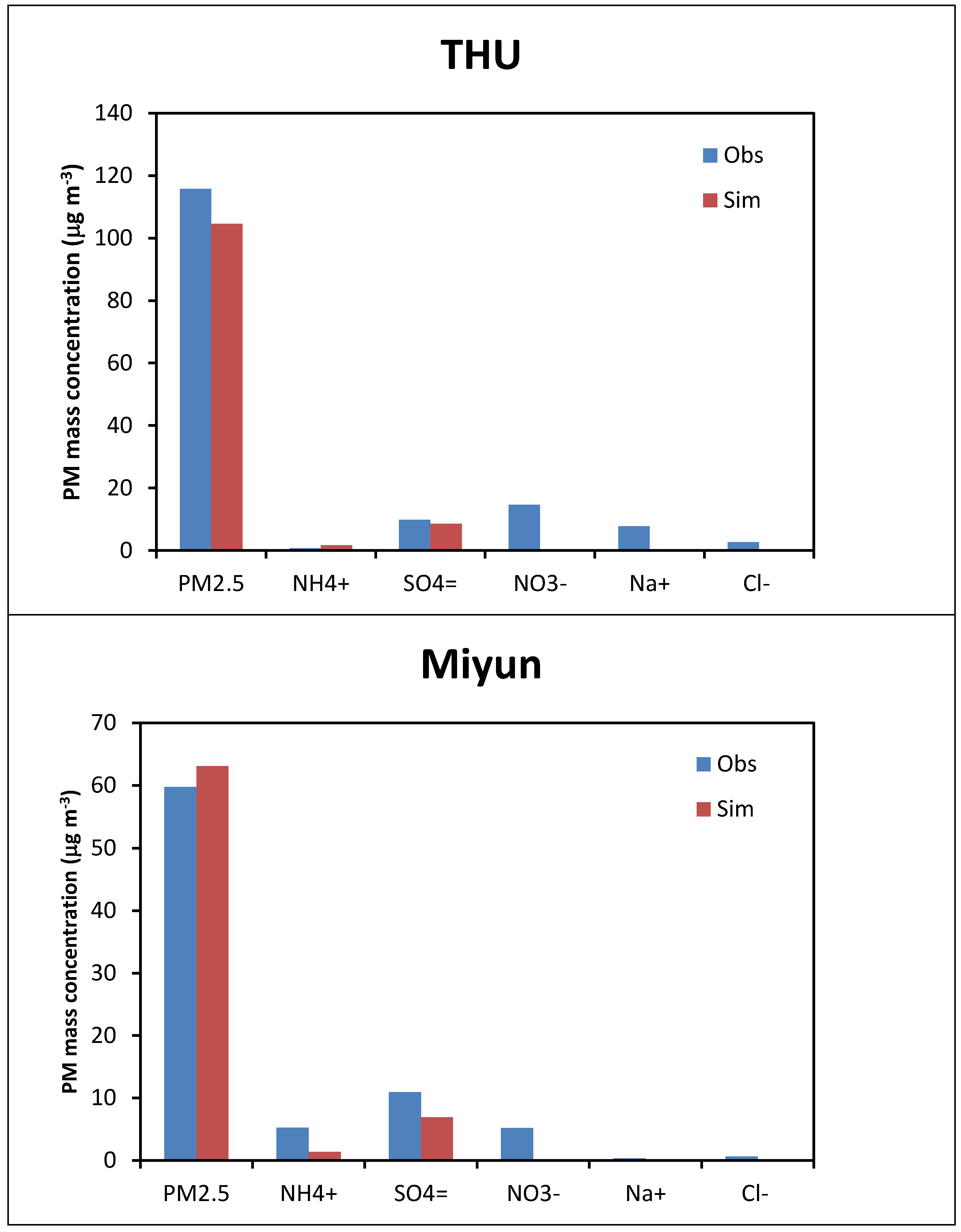
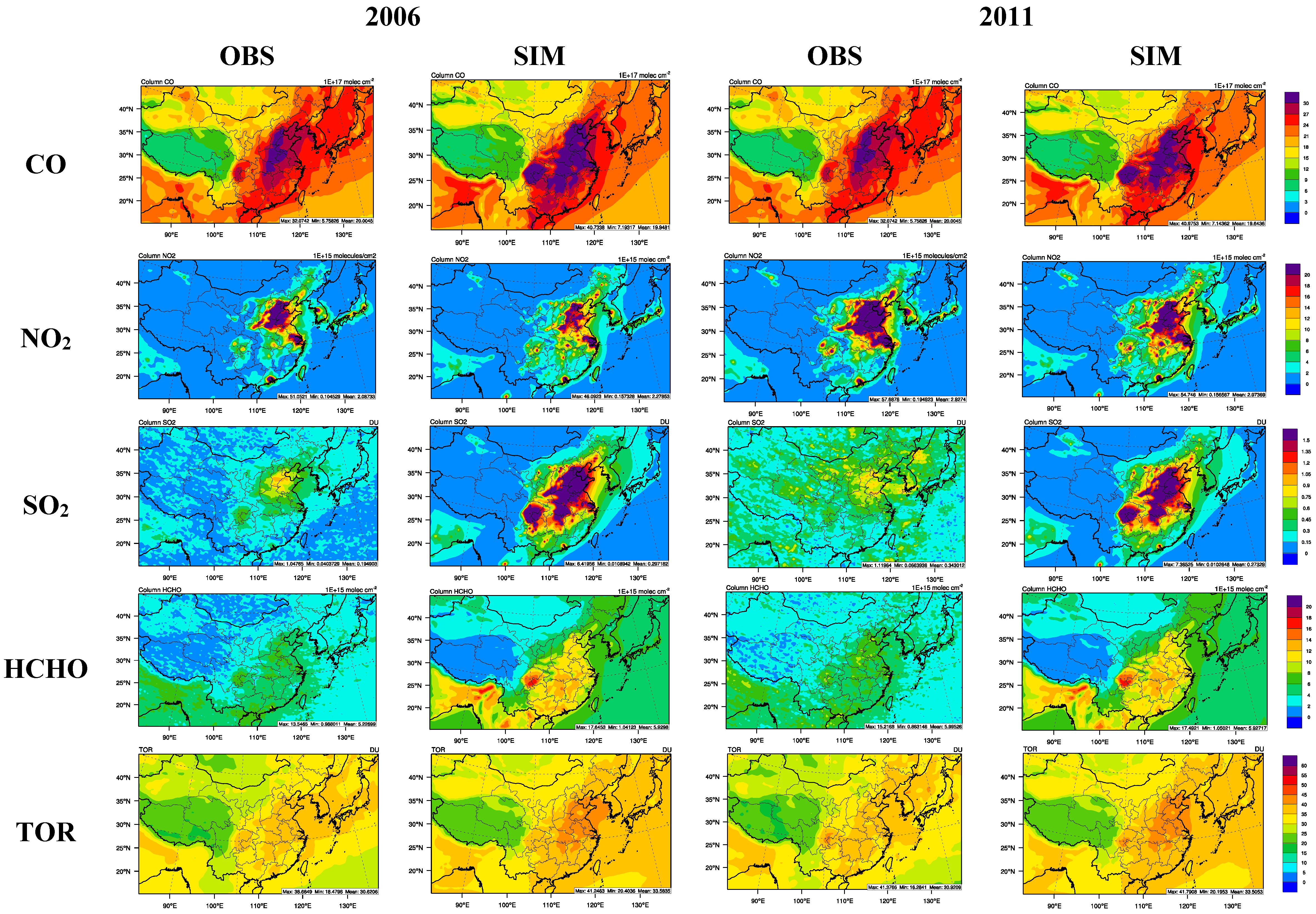
4. Model Responses to Changes in Emissions and Meteorology in 2011 Relative to 2006
| Variable | 2006 | 2011 | Absolute Difference | % Difference | |||||
|---|---|---|---|---|---|---|---|---|---|
| Obs. | Sim. | Obs. | Sim. | Obs. | Sim. | Obs. | Sim. | ||
| P | 939.7 | 925.8 | 942.0 | 928.6 | 2.3 | 2.8 | 0.2 | 0.3 | |
| T2 (°C) | 13.8 | 12.9 | 13.5 | 12.4 | −0.3 | −0.5 | −2.2 | −3.9 | |
| Q2 (g∙kg−1) | 7.95 | 7.98 | 7.98 | 8.04 | 0.03 | 0.4 | 0.06 | 0.8 | |
| WS10 (m∙s−1) | 3.09 | 3.43 | 3.04 | 3.41 | −0.05 | −0.02 | −0.9 | −0.6 | |
| Precip (NCDC) (mm∙day−1) | 2.7 | 3 | 2.6 | 2.9 | −0.1 | −0.1 | −3.7 | −3.3 | |
| Precip (GPCP) (mm∙day−1) | 2.9 | 3.1 | 3.1 | 3.2 | 0.2 | 0.1 | 6.9 | 3.2 | |
| CCN (cm−2) | 0.82 | 0.54 | 0.76 | 0.51 | −0.06 | −0.03 | −7.3 | −5.6 | |
| CDNC (cm−3) | 143 | 101 | 140.3 | 97.6 | −2.7 | −3.4 | −1.9 | −3.4 | |
| CF | 0.64 | 0.56 | 0.65 | 0.61 | 0.01 | 0.05 | 1.6 | 8.9 | |
| PWV (cm) | 2.25 | 2.23 | 2.14 | 2.18 | −0.11 | −0.05 | −4.9 | −2.2 | |
| LWP (g∙m−2) | 110.3 | 48 | 101.1 | 50.7 | −9.2 | 2.7 | −8.3 | 5.6 | |
| IWP (g∙m−2) | 245.1 | 9.5 | 222.9 | 9.6 | −22.2 | 0.1 | −9.1 | 1.1 | |
| AOD | 0.33 | 0.21 | 0.31 | 0.17 | −0.02 | −0.04 | −6.1 | −19.0 | |
| COT | 16.3 | 8.2 | 15.2 | 8.5 | −1.1 | 0.3 | −6.7 | 3.7 | |
| GLW (W∙m−2) | 324.6 | 317.4 | 324.4 | 315.2 | −0.2 | −2.2 | −0.1 | −0.7 | |
| SWD (W∙m−2) | 183.4 | 204.9 | 179.7 | 202.6 | −3.7 | −2.3 | −2.0 | −1.1 | |
| SWCF (W∙m−2) | −51.7 | −42 | −54 | −45.6 | −2.3 | −3.6 | 4.4 | 8.6 | |
| LWCF (W∙m−2) | 29.1 | 18.5 | 28.8 | 19.9 | −0.3 | 1.4 | −1.0 | 7.6 | |
| Col. CO | 2.007 | 2.014 | 2.015 | 1.978 | 0.008 | −0.036 | 0.4 | −1.8 | |
| Col. NO2 (1015 molecular∙cm−2) | 2.3 | 2.5 | 3.3 | 3.3 | 1 | 0.8 | 43.5 | 32.0 | |
| Col. SO2 (DU) | 0.20 | 0.33 | 0.35 | 0.30 | 0.15 | −0.03 | 75.0 | −9.1 | |
| Col. HCHO (1015 molecular∙cm−2) | 5.3 | 6.1 | 6.1 | 6.0 | 0.8 | −0.03 | 14.8 | −0.5 | |
| TOR (DU) | 30.7 | 33.6 | 31.1 | 33.5 | 0.4 | −0.1 | 1.3 | −0.3 | |
| PM10 | 98.6 | 97.8 | 89.5 | 86.2 | −9.1 | −11.6 | −9.2 | −11.9 | |
| NO2 (µg∙m−3) | 125.8 | 16 | 117.3 | 61.1 | −8.5 | 45.1 | −6.8 | 281.9 | |
| SO2 (µg∙m−3) | 101.5 | 67.1 | 94.7 | 77.5 | −6.8 | 10.4 | −6.7 | 15.5 | |
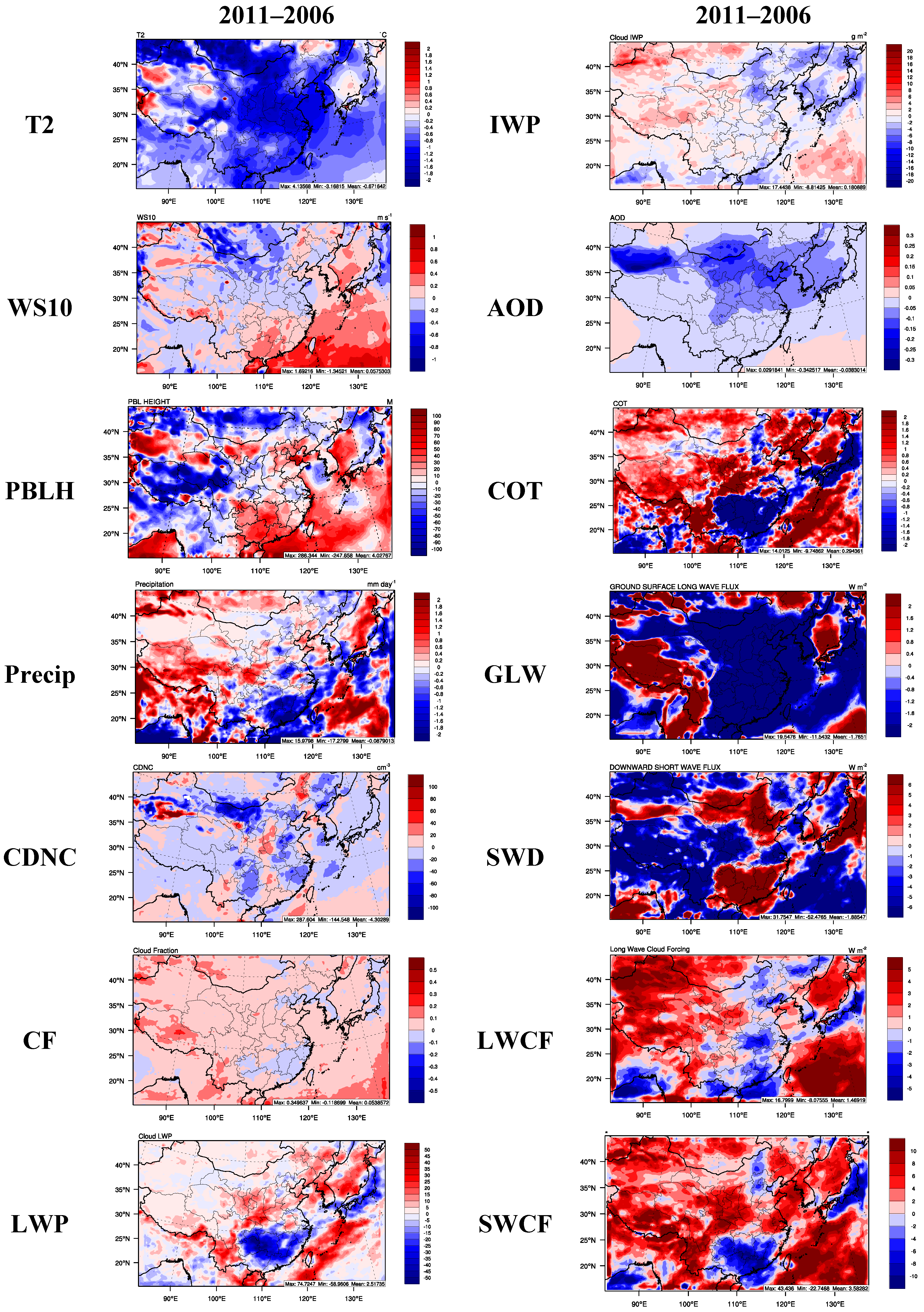
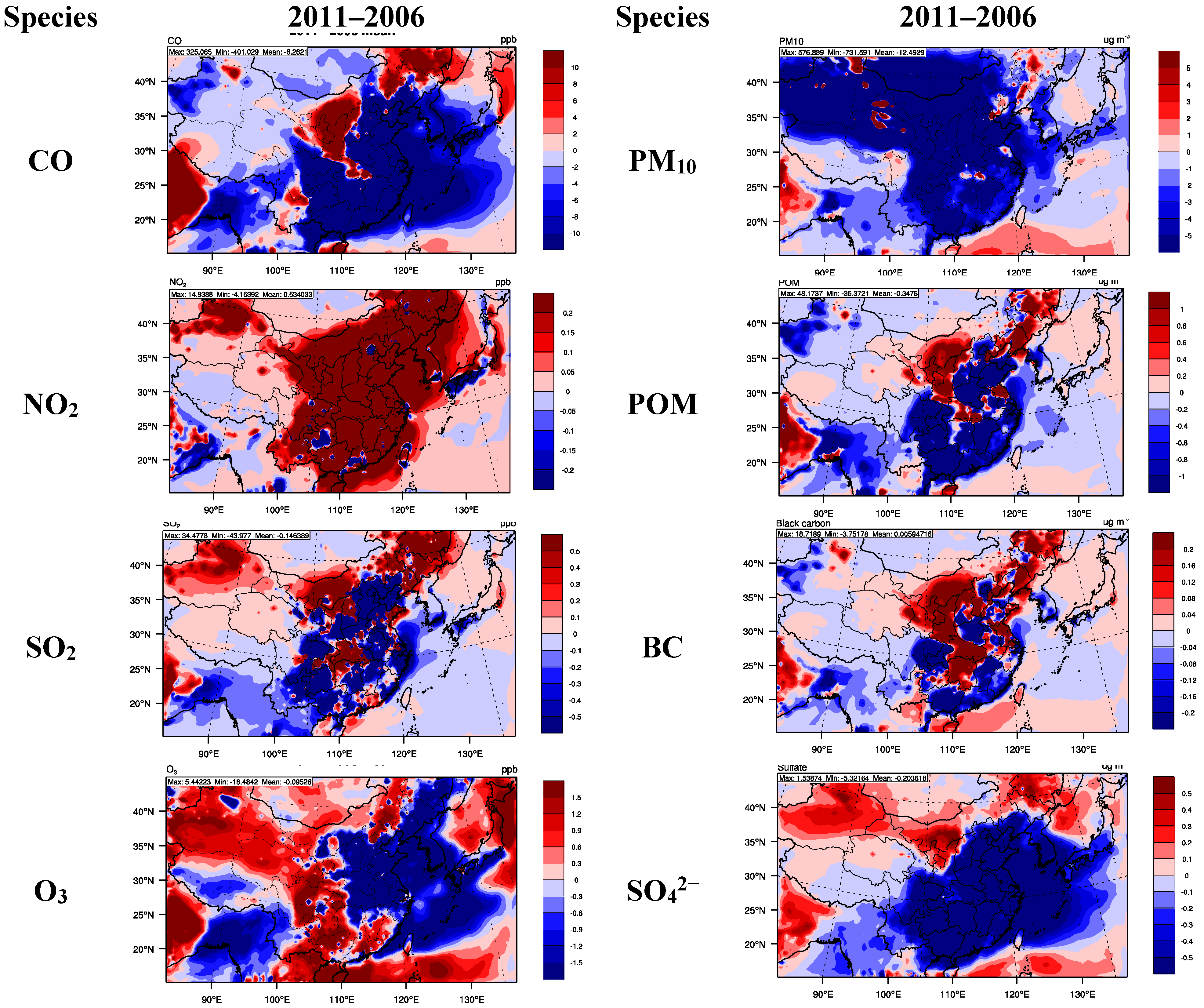
5. Summary and Conclusions
Supplementary Files
Supplementary File 1Acknowledgments
Author Contributions
Conflicts of Interest
References
- Zhang, Y. Online coupled meteorology and chemistry models: History, current status, and outlook. Atmos. Chem. Phys. 2008, 8, 2895–2932. [Google Scholar] [CrossRef]
- Grell, G.A.; Baklanov, A. Integrated modelling for forecasting weather and air quality: A call for fully coupled approaches. Atmos. Environ. 2011, 45, 6845–6851. [Google Scholar] [CrossRef]
- Kukkonen, J.; Olsson, T.; Schultz, D.M.; Baklanov, A.; Klein, T.; Miranda, A.I.; Monteiro, A.; Hirtl, M.; Tarvainen, V.; Boy, M.; et al. A review of operational, regional- scale, chemical weather forecasting models in Europe. Atmos. Chem. Phys. 2012, 12, 1–87. [Google Scholar] [CrossRef] [Green Version]
- Baklanov, A.; Schlünzen, K.; Suppan, P.; Baldasano, J.; Brunner, D.; Aksoyoglu, S.; Carmichael, G.; Douros, J.; Flemming, J.; Forkel, R.; et al. Online coupled regional meteorology-chemistry models in Europe: Current status and prospects. Atmos. Chem. Phys. 2014, 14, 317–398. [Google Scholar]
- Grell, G.A.; Peckham, S.E.; Schmitz, R.; McKeen, S.A.; Frost, G.; Skamarock, W.C.; Eder, B. Fully coupled “online” chemistry within the WRF model. Atmos. Environ. 2005, 39, 6957–6975. [Google Scholar] [CrossRef]
- Ma, P.-L.; Rasch, P.J.; Fast, J.D.; Easter, R.C.; Gustafson, W.I., Jr.; Liu, X.; Ghan, S.J.; Singh, B. Assessing the CAM5 physics suite in the WRF-Chem model: Implementation, resolution sensitivity, and a first evaluation for a regional case study. Geosci. Model Dev. 2014, 7, 755–778. [Google Scholar] [CrossRef]
- Lim, K.-S.; Fan, J.-W.; Leung, L.R.; Ma, P.-L.; Singh, B.; Zhao, C.; Zhang, Y.; Zhang, G.; Song, X.-L. Investigation of aerosol indirect effects using a cumulus microphysics parameterization with in a regional climate model. J. Geophys. Res. 2014, 116, D02204. [Google Scholar] [CrossRef]
- Neale, R.B.; Chen, C.-C.; Gettelman, A.; Lauritzen, P.H.; Park, S.; Williamson, D.L.; Conley, A.J.; Garcia, R.; Kinnison, D.; Lamarque, J.-F.; et al. Description of the NCAR Community Atmosphere Model (CAM5), Technical Report NCAR/TN-486+STR; National Center for Atmospheric Research: Boulder, CO, USA, 2010; p. 268. [Google Scholar]
- Liu, X.; Easter, R.C.; Ghan, S.J.; Zaveri, R.; Rasch, P.; Shi, X.; Lamarque, J.-F.; Gettelman, A.; Morrison, H.; Vitt, F.; et al. Toward a minimal representation of aerosols in climate models: Description and evaluation in the Community Atmosphere Model CAM5. Geosci. Model Dev. 2012, 5, 709–739. [Google Scholar] [CrossRef]
- Meyers, M.P.; DeMott, P.J.; Cotton, W.R. New primary ice-nucleation parameterizations in an explicit cloud model. J. Appl. Meteorol. 1992, 31, 708–721. [Google Scholar] [CrossRef]
- Niemand, M.; Mohler, O.; Vogel, B.; Vogel, H.; Hoose, C.; Connolly, P.; Klein, H.; Bingemer, H.; DeMott, P.; Skrotzki, J.; Leisner, T. A particle-surface-area-based parameterization of immersion freezing on desert dust particles. J. Atmos. Sci. 2012, 69, 3077–3092. [Google Scholar] [CrossRef]
- Phillips, V.T.J.; Demott, P.J.; Andronache, C.; Pratt, K.A.; Prather, K.A.; Subramanian, R.; Twohy, C. Improvements to an empirical parameterization of heterogeneous ice nucleation and its comparison with observations. J. Atmos. Sci. 2013, 70, 378–409. [Google Scholar] [CrossRef]
- DeMott, P.J.; Prenni, A.J.; McMeeking, G.R.; Sullivan, R.C.; Petters, M.D.; Tobo, Y.; Niemand, M.; Möhler, O.; Snider, J.R.; Sever, G.; et al. Integrating laboratory and field data to quantify the immersion freezing ice nucleation activity of mineral dust particles. Atmos. Chem. Phys. 2015, 15, 393–409. [Google Scholar] [CrossRef]
- Hao, J.-M.; He, K.-B.; Duan, L.; Li, J.-H.; Wang, L.-T. Air pollution and its control in China. Front. Environ. Sci. Eng. 2007, 1, 129–142. [Google Scholar] [CrossRef]
- Mlawer, E.J.; Taubman, S.J.; Brown, P.D.; Iacono, M.J.; Clough, S.A. Radiative transfer for inhomogeneous atmospheres: RRTM, a validated correlated-k model for the longwave. J. Geophys. Res. 1997, 102, 16663–16682. [Google Scholar] [CrossRef]
- Iacono, M.J.; Delamere, J.S.; Mlawer, E.J.; Shephard, M.W.; Clough, S.A.; Collins, W.D. Radiative forcing by long-lived greenhouse gases: Calculations with the AER radiative transfer models. J. Geophys. Res. 2008, 113, D13103. [Google Scholar] [CrossRef]
- Tewari, M.; Chen, F.; Wang, W.; Dudhia, J.; LeMone, M.A.; Mitchell, K.; Ek, M.; Gayno, G.; Wegiel, J.; Cuenca, R.H. Implementation and verification of the unified NOAH land surface model in the WRF model. In Proceedings of the 20th Conference on Weather Analysis and Forecasting/16th Conference on Numerical Weather Prediction, Seattle, WA, USA, 12–16 January 2004.
- Monin, A.S.; Obukhov, A.M. Basic laws of turbulent mixing in the surface layer of the atmosphere. Akademiya Nauk SSSR 1954, 151, 163–187. [Google Scholar]
- Janjic, Z.I. Nonsingular Implementation of the Mellor-Yamada Level 2.5 Scheme in the NCEP Meso Model, NCEP Off. Note; National Center for Environmental Prediction: College Park, MD, USA, 2002. [Google Scholar]
- Bretherton, C.S.; Park, S. A new moist turbulence parameterization in the community atmosphere model. J. Clim. 2009, 22, 3422–3448. [Google Scholar] [CrossRef]
- Zhang, G.J.; McFarlane, N.A. Sensitivity of climate simulations to the parameterization of cumulus convection in the Canadian Climate Centre general circulation model. Atmos. Ocean 1995, 33, 407–446. [Google Scholar] [CrossRef]
- Song, X.; Zhang, G.J. Microphysics parameterization for convective clouds in a global climate model: Description and single-column model tests. J. Geophys. Res. 2011, 116, D02201. [Google Scholar] [CrossRef]
- Morrison, H.; Gettelman, A. A new two-moment bulk stratiform cloud microphysics scheme in the Community Atmosphere Model, Version 3 (CAM3). Part I: Description and numerical tests. J. Clim. 2008, 21, 3642–3659. [Google Scholar] [CrossRef]
- Madronich, S. Photodissociation in the atmosphere: 1. Actinic flux and the effect of ground reflections and clouds. J. Geophys. Res. 1987, 92, 9740–9752. [Google Scholar] [CrossRef]
- Tie, X.; Madronich, S.; Walters, S.; Zhang, R.; Racsh, P.; Collins, W. Effect of clouds on photolysis and oxidants in the troposphere. J. Geophys. Res. 2003. [Google Scholar] [CrossRef]
- Abdul-Razzak, H.; Ghan, S.J. A parameterization of aerosol activation 3, Sectional representation. J. Geophys. Res. 2002, 107, D34026. [Google Scholar] [CrossRef]
- Liu, X.H.; Penner, J.E.; Das, B.; Bergmann, D.; Rodriguez, J.M.; Strahan, S.; Wang, M.; Feng, Y. Uncertainties in global aerosol simulations: Assessment using three meteorological datasets. J. Geophys. Res. 2007, 112, D11212. [Google Scholar] [CrossRef]
- Bigg, E.K. The formation of atmospheric ice crystals by the freezing of droplets. Q. J. R. Meteorol. Soc. 1953, 79, 510–519. [Google Scholar] [CrossRef]
- Young, K.C. The role of contact nucleation in ice phase initiation. J. Atmos. Sci. 1974, 31, 768–776. [Google Scholar] [CrossRef]
- Zaveri, R.A.; Peters, L.K. A new lumped structure photochemical mechanism for large-scale applications. J. Geophys. Res. 1999, 104, 30387–30415. [Google Scholar] [CrossRef]
- Barth, M.C.; Rasch, P.J.; Kiehl, J.T.; Benkovitz, C.M.; Schwartz, S.E. Sulfur chemistry in the National Center for Atmospheric Research Community Climate Model: Description, evaluation, features, and sensitivity to aqueous chemistry. J. Geophys. Res. 2000, 105, 1387–1415. [Google Scholar] [CrossRef]
- Binkowski, F.S.; Roselle, S.J. Models-3 Community Multiscale Air Quality (CMAQ) model aerosol component, 1, Model description. J. Geophys. Res. 2003. [Google Scholar] [CrossRef]
- Zhang, Q.; Streets, D.G.; Carmichael, G.R.; He, K.B.; Huo, H.; Kannari, A.; Klimont, Z.; Park, I.S.; Reddy, S.; Fu, J.S.; et al. Asian emissions in 2006 for the NASA INTEX-B mission. Atmos. Chem. Phys. 2009, 9, 5131–5153. [Google Scholar] [CrossRef]
- Guenther, A.; Karl, T.; Harley, P.; Wiedinmyer, C.; Palmer, P.I.; Geron, C. Estimates of global terrestrial isoprene emissions using MEGAN (Model of Emissions of Gases and Aerosols from Nature). Atmos. Chem. Phys. 2006, 6, 3181–3210. [Google Scholar] [CrossRef]
- Zender, C.S.; Bian, H.; Newman, D. Mineral dust entrainment and deposition (DEAD) model: Description and 1990s dust climatology. J. Geophys. Res. 2003, 108, D144416. [Google Scholar] [CrossRef]
- Wang, K.; Zhang, Y.; Nenes, A.; Fountoukis, C. Implementation of dust emission and chemistry into the Community Multiscale Air Quality modeling system and initial application to an Asia dust storm episode. Atmos. Chem. Phys. 2012, 12, 10209–10237. [Google Scholar] [CrossRef]
- Gong, S.L.; Barrie, L.A.; Lazare, M. Canadian Aerosol Module (CAM): A size-segregated simulation of atmospheric aerosol processes for climate and air quality models: 2. Global sea-salt aerosol and its budgets. J. Geophys. Res. 2002, 107, D244779. [Google Scholar] [CrossRef]
- Duan, F.; He, K.; Ma, Y.; Yang, F.; Yu, X.; Cadle, S.; Chan, T.; Mulawa, P.A. Concentration and chemical characteristic of PM2.5 in Beijing, China: 2001–2002. Sci. Total Environ. 2006, 335, 264–275. [Google Scholar] [CrossRef] [PubMed]
- Environmental Protection Department (EPD). Hong Kong. The 2006 Hong Kong Air Quality Status Report, EPD/TR 01/07; Environmental Protection Department: Hong Kong, China, 2006. [Google Scholar]
- Bennartz, R. Global assessment of marine boundary layer cloud droplet number concentration from satellite. J. Geophys. Res. 2007, 112, D02201. [Google Scholar]
- Seethala, C.; Horváth, Á. Global assessment of AMSR-E and MODIS cloud liquid water path retrievals in warm oceanic clouds. J. Geophys. Res. 2010, 115, D13202. [Google Scholar] [CrossRef]
- Zhang, Y.; Chen, Y.-C.; Sarwar, G.; Schere, K. Impact of gas-phase mechanisms on Weather Research Forecasting Model with Chemistry (WRF/Chem) predictions: Mechanism implementation and comparative evaluation. J. Geophys. Res. 2012, 117. [Google Scholar] [CrossRef]
- Ma, L.-J.; Zhang, T.-J.; Li, Q.-X.; Frauenfeld, O.W.; Qin, D. Evaluation of ERA-40, NCEP-1, and NCEP-2 reanalysis air temperatures with ground-based measurements in China. J. Geophys. Res. 2008, 113, D15115. [Google Scholar] [CrossRef]
- Zhang, Y.; Chen, S.-H.; Chen, Y.-S.; Wang, W.-X. Application of MM5 in China: Model evaluation, seasonal variations, and sensitivity to horizontal grid resolutions. Atmos. Environ. 2011, 45, 3454–3465. [Google Scholar] [CrossRef]
- Cai, C.-J.; Zhang, X.; Wang, K.; Zhang, Y.; Wang, L.-T.; Zhang, Q.; Duan, F.-K.; He, K.-B. Incorporation of new particle formation and early growth treatments into WRF/Chem and its application over East Asia: Model improvement, evaluation, and the nucleation-aerosol-cloud-meteorology interactions. Atmos. Environ. 2015. [Google Scholar] [CrossRef]
- Jiang, F.; Liu, Q.; Huang, X.X.; Wang, T.J.; Zhuang, B.L.; Xie, M. Regional modeling of secondary organic aerosol over China using WRF/Chem. J. Aerosol. Sci. 2012, 43, 57–73. [Google Scholar] [CrossRef]
- Liao, J.B.; Wang, T.J.; Wang, X.M.; Xie, M.; Jiang, Z.Q.; Huang, X.X.; Zhu, J.L. Impacts of different urban canopy schemes in WRF/Chem on regional climate and air quality in Yangtze River Delta. China Atmos. Res. 2014, 145, 226–243. [Google Scholar] [CrossRef]
- Brunner, D.; Savage, N.; Jorba, O.; Ederd, B.; Giordanoa, L.; Badiac, A.; Balzarinie, A.; Baróf, R.; Bianconig, R.; Chemel, C.; et al. Evaluation of the meteorological performance of coupled chemistry-meteorology models in the context of AQMEII phase 2. Atmos. Environ. 2014. [Google Scholar] [CrossRef]
- Emery, C.; Tai, E.; Yarwood, G. Enhanced Meteorological Modeling and Performance Evaluation for Two Texas Ozone Episodes, Final Report, The Texas Natural Resource Conservation Commission, 12118 Park 35 Circle Austin, Texas 78753. Available online: http://www.tceq.state.tx.us/assets/public/implementation/air/am/contracts/reports/mm/EnhancedMetModelingAndPerformanceEvaluation.pdf (accessed on 28 May 2014).
- Wang, K.; Zhang, Y.; Jang, C.J.; Phillips, S.; Wang, B.-Y. Modeling study of intercontinental air pollution transport over the trans-pacific region in 2001 using the community multiscale air quality modeling system. J. Geophys. Res. 2009, 114, D04307. [Google Scholar]
- Zhang, Y.; Karamchandani, P.; Glotfelty, T.; Streets, D.G.; Grell, G.; Nenes, A.; Yu, F.-Q.; Bennartz, R. Development and initial application of the global-through-urban weather research and forecasting model with chemistry (GU-WRF/Chem). J. Geophys. Res. 2012, 117, D20206. [Google Scholar] [CrossRef]
- Zhang, Y.; Sartelet, K.; Wu, S.-Y.; Seigneur, C. Application of WRF/Chem-MADRID and WRF/Polyphemus in Europe, Part I: Model description and evaluation of meteorological predictions. Atmos. Chem. Phys. 2013, 13, 6807–6843. [Google Scholar] [CrossRef]
- Wang, L.T.; Zhang, Y.; Wang, K.; Zheng, B.; Zhang, Q. Application of online Weather Research Forecasting Model with Chemistry (WRF/Chem) over the north China: Sensitivity study, comparative evaluation and policy implications. Atmos. Environ. 2015. [Google Scholar] [CrossRef]
- Liu, X.-Y.; Zhang, Y.; Zhang, Q.; He, K.-B. Application of online-coupled WRF/Chem-MADRID in East Asia: Model evaluation and climatic effects of anthropogenic aerosols. Atmos. Environ. 2015. [Google Scholar] [CrossRef]
- Zhang, Y.; Zhang, X.; Wang, K.; He, J.; Leung, L.R.; Fan, J.-W.; Nenes, A. Incorporating an advanced aerosol activation parameterization into WRF-CAM5: Model evaluation and parameterization intercomparison. J. Geophys. Res. 2015. [Google Scholar] [CrossRef]
- Alapaty, K.; Herwehe, J.A.; Otte, T.L.; Nolte, C.G.; Bullock, O.R.; Mallard, M.S.; Kain, J.S.; Dudhia, J. Introducing subgrid-scale cloud feedbacks to radiation for regional meteorological and climate modeling. Geophys. Res. Lett. 2012, 39, L24809. [Google Scholar] [CrossRef]
- Gantt, B.; He, J.; Zhang, X.; Zhang, Y.; Nenes, A. Incorporation of advanced aerosol activation treatments into CESM/CAM5: Model evaluation and impacts on aerosol indirect forcing. Atmos. Chem. Phys. 2014, 14, 7485–7497. [Google Scholar] [CrossRef]
- Kim, S.; Yoon, S.; Kim, J.; Kim, S. Seasonal and monthly variations of columnar aerosol optical properties over East Asia determined from multi-year MODIS, LIDAR, and AERONET Sun/sky radiometer measurements. Atmos. Environ. 2007, 41, 1634–1651. [Google Scholar] [CrossRef]
- Gao, Y.; Zhao, C.; Liu, X.H.; Zhang, M.G.; Leung, L.R. WRF-Chem simulations of aerosols and anthropogenic aerosol radiative forcing in East Asia. Atmos. Environ. 2014, 92, 250–266. [Google Scholar] [CrossRef]
- Gong, S.L. A parameterization of sea-salt aerosol source function for sub- and super- micron particles. Glob. Biogeochem. Cycles 2003, 17. [Google Scholar] [CrossRef]
- Zhang, X.Y.; Gong, S.L.; Shen, Z.X.; Mei, F.M.; Xi, X.X.; Liu, L.C.; Zhou, Z.J.; Wang, D.; Wang, Y.Q.; Cheng, Y. Characterization of soil dust aerosol in China and its transport and distribution during 2001 ACE-Asia: 1. Network observations. J. Geophys. Res. 2003, 108. [Google Scholar] [CrossRef]
- Liu, X.-H.; Zhang, Y.; Xing, J.; Zhang, Q.; Wang, K.; Streets, D.G.; Jang, C.J.; Wang, W.-X.; Hao, J.-M. Understanding of Regional Air Pollution over China using CMAQ: Part II. Process Analysis and Ozone Sensitivity to Precursor Emissions. Atmos. Environ. 2010, 44, 3719–3727. [Google Scholar] [CrossRef]
- Streets, D.G.; Yarber, K.F.; Woo, J.-H.; Carmichael, G.R. Biomass burning in Asia: Annual and seasonal estimates and atmospheric emissions. Glob. Biogeochem. Cycles 2003, 17, 1099. [Google Scholar] [CrossRef]
- Lee, C.; Martin, R.V.; van Donkelaar, A.; O’Byrne, G.; Krotkov, N.; Richter, A.; Huey, L.G.; Holloway, J.S. Retrieval of vertical columns of sulfur dioxide from SCIAMACHY and OMI: Air mass factor algorithm development, validation, and error analysis. J. Geophys. Res. 2009, 114, D22303. [Google Scholar] [CrossRef]
- De Smedt, I.; Müller, J.-F.; Stavrakou, T.; van der, R.J.; Eskes, A.H.J.; van Roozendael, M. Twelve years of global observations of formaldehyde in the troposphere using GOME and SCIAMACHY sensors. Atmos. Chem. Phys. 2008, 8, 4947–4963. [Google Scholar] [CrossRef]
- Shi, Y.; Xia, Y.; Lu, B.; Liu, N.; Zhang, L.; Li, S.; Li, W. Emission inventory and trends of NOx for China, 2000–2020. J. Zhejiang Univ. Sci. A (Appl. Phys. Eng.) 2014, 15, 454–464. [Google Scholar] [CrossRef]
- Wang, Y.; Zhang, Q.Q.; He, K.; Zhang, Q.; Chai, L. Sulfate-nitrate-ammonium aerosols over China: Response to 2000–2015 emission changes of sulfur dioxide, nitrogen oxides, and ammonia. Atmos. Chem. Phys. 2013, 13, 2635–2652. [Google Scholar] [CrossRef]
- Zhang, Y.; Easter, R.C.; Ghan, S.J.; Abdul-Razzak, H. Impact of aerosol size representation on modeling aerosol-cloud interactions. J. Geophys. Res. 2002. [Google Scholar] [CrossRef]
© 2015 by the authors; licensee MDPI, Basel, Switzerland. This article is an open access article distributed under the terms and conditions of the Creative Commons Attribution license (http://creativecommons.org/licenses/by/4.0/).
Share and Cite
Chen, Y.; Zhang, Y.; Fan, J.; Leung, L.-Y.R.; Zhang, Q.; He, K. Application of an Online-Coupled Regional Climate Model, WRF-CAM5, over East Asia for Examination of Ice Nucleation Schemes: Part I. Comprehensive Model Evaluation and Trend Analysis for 2006 and 2011. Climate 2015, 3, 627-667. https://doi.org/10.3390/cli3030627
Chen Y, Zhang Y, Fan J, Leung L-YR, Zhang Q, He K. Application of an Online-Coupled Regional Climate Model, WRF-CAM5, over East Asia for Examination of Ice Nucleation Schemes: Part I. Comprehensive Model Evaluation and Trend Analysis for 2006 and 2011. Climate. 2015; 3(3):627-667. https://doi.org/10.3390/cli3030627
Chicago/Turabian StyleChen, Ying, Yang Zhang, Jiwen Fan, Lai-Yung R. Leung, Qiang Zhang, and Kebin He. 2015. "Application of an Online-Coupled Regional Climate Model, WRF-CAM5, over East Asia for Examination of Ice Nucleation Schemes: Part I. Comprehensive Model Evaluation and Trend Analysis for 2006 and 2011" Climate 3, no. 3: 627-667. https://doi.org/10.3390/cli3030627
APA StyleChen, Y., Zhang, Y., Fan, J., Leung, L.-Y. R., Zhang, Q., & He, K. (2015). Application of an Online-Coupled Regional Climate Model, WRF-CAM5, over East Asia for Examination of Ice Nucleation Schemes: Part I. Comprehensive Model Evaluation and Trend Analysis for 2006 and 2011. Climate, 3(3), 627-667. https://doi.org/10.3390/cli3030627





